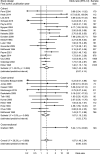Adverse pregnancy and birth outcomes associated with Mycoplasma hominis, Ureaplasma urealyticum and Ureaplasma parvum: a systematic review and meta-analysis
- PMID: 36028274
- PMCID: PMC9422885
- DOI: 10.1136/bmjopen-2022-062990
Adverse pregnancy and birth outcomes associated with Mycoplasma hominis, Ureaplasma urealyticum and Ureaplasma parvum: a systematic review and meta-analysis
Erratum in
-
Correction: Adverse pregnancy and birth outcomes associated with Mycoplasma hominis, Ureaplasma urealyticum and Ureaplasma parvum: a systematic review and meta-analysis.BMJ Open. 2023 Sep 22;13(9):e062990corr1. doi: 10.1136/bmjopen-2022-062990corr1. BMJ Open. 2023. PMID: 37739477 Free PMC article. No abstract available.
Abstract
Objectives: Mycoplasma hominis, Ureaplasma urealyticum and Ureaplasma parvum (genital mycoplasmas) commonly colonise the urogenital tract in pregnant women. This systematic review aims to investigate their role in adverse pregnancy and birth outcomes, alone or in combination with bacterial vaginosis (BV).
Methods: We searched Embase, Medline and CINAHL databases from January 1971 to February 2021. Eligible studies tested for any of the three genital mycoplasmas during pregnancy and reported on the primary outcome, preterm birth (PTB) and/or secondary outcomes low birth weight (LBW), premature rupture of membranes (PROM), spontaneous abortion (SA) and/or perinatal or neonatal death (PND).Two reviewers independently screened titles and abstracts, read potentially eligible full texts and extracted data. Two reviewers independently assessed risks of bias using published checklists. Random effects meta-analysis was used to estimate summary ORs (with 95% CIs and prediction intervals). Multivariable and stratified analyses were synthesised descriptively.
Results: Of 57/1194 included studies, 39 were from high-income countries. In meta-analysis of unadjusted ORs, M. hominis was associated with PTB (OR 1.87, 95% CI 1.49 to 2.34), PROM, LBW and PND but not SA. U. urealyticum was associated with PTB (OR 1.84, 95% CI 1.34 to 2.55), PROM, LBW, SA and PND. U. parvum was associated with PTB (1.60, 95% CI 1.12 to 2.30), PROM and SA. Nine of 57 studies reported any multivariable analysis. In two studies, analyses stratified by BV status showed that M. hominis and U. parvum were more strongly associated with PTB in the presence than in the absence of BV. The most frequent source of bias was a failure to control for confounding.
Conclusions: The currently available literature does not allow conclusions about the role of mycoplasmas in adverse pregnancy and birth outcomes, alone or with coexisting BV. Future studies that consider genital mycoplasmas in the context of the vaginal microbiome are needed.
Prospero registration number: CRD42016050962.
Keywords: EPIDEMIOLOGY; Epidemiology; GYNAECOLOGY; MICROBIOLOGY; OBSTETRICS.
© Author(s) (or their employer(s)) 2022. Re-use permitted under CC BY. Published by BMJ.
Conflict of interest statement
Competing interests: NL is on the advisory board of Sefunda AG, a start-up company that develops point-of-care tests for sexually transmitted infections.
Figures



Comment in
-
Excerpts from the World Obstetrics Literature: Obstetrics.J Obstet Gynaecol Can. 2023 Apr;45(4):249-252. doi: 10.1016/j.jogc.2023.03.002. J Obstet Gynaecol Can. 2023. PMID: 37149337 No abstract available.
-
La littérature médicale mondiale : obstétrique.J Obstet Gynaecol Can. 2023 Apr;45(4):253-256. doi: 10.1016/j.jogc.2023.04.001. J Obstet Gynaecol Can. 2023. PMID: 37149338 No abstract available.
References
-
- Horner P, Donders G, Cusini M, et al. . Should we be testing for urogenital Mycoplasma hominis, Ureaplasma parvum and Ureaplasma urealyticum in men and women? - a position statement from the European STI Guidelines Editorial Board. J Eur Acad Dermatol Venereol 2018;32:1845–51. 10.1111/jdv.15146 - DOI - PubMed
Publication types
MeSH terms
Grants and funding
LinkOut - more resources
Full Text Sources
Medical
